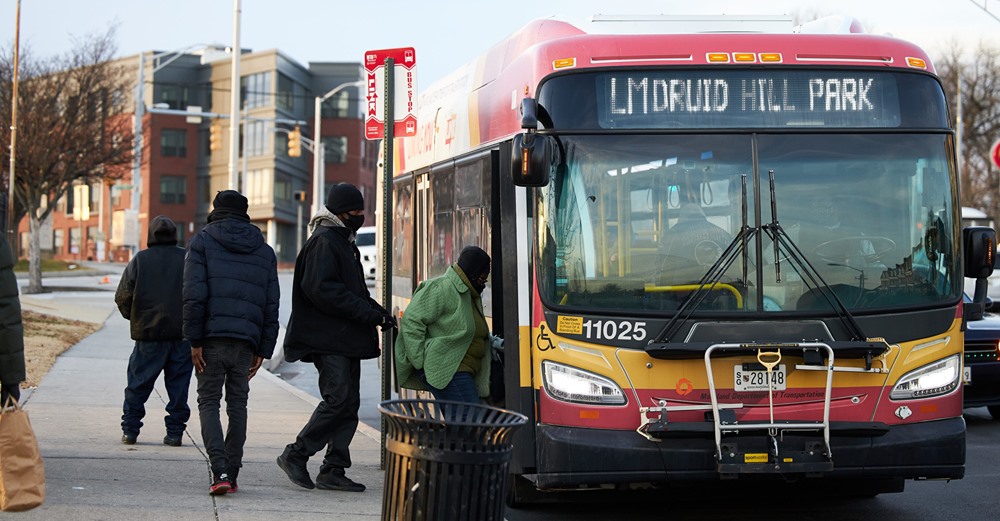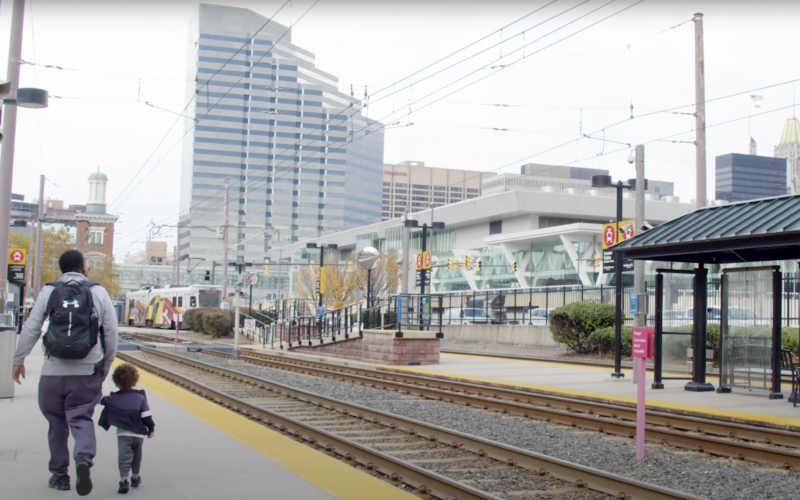
Photo Credit: O'Doherty Photography
Throughout the U.S., it’s standard for states to spend vastly more on road projects than on transit. But perhaps nowhere is this gap more pronounced than in Maryland under Governor Larry Hogan.
Since his election in 2015, Hogan has lavished billions of dollars on road expansions and the state’s highway system. Meanwhile, the Maryland Transit Administration has sunk into disrepair.
The transit agency — which carries more bus riders than all but 10 other U.S. agencies — faces a $2 billion maintenance backlog, and its rail systems have the highest major breakdown rates in the country, according to a 2019 analysis by the Federal Transit Administration. Baltimore transit riders are largely low-income and Black, while the beneficiaries of Maryland’s road spending are primarily affluent and white. One in three Baltimore transit commuters is an essential worker, holding the city together during the pandemic while navigating the city’s spotty and unreliable transit system.
To dispel these inequities, a new coalition of environmental, labor, and business leaders is working with elected officials in Baltimore to pass the Transit Safety and Investment Act, a bill currently moving through the Maryland state legislature. The bill would require the Maryland Department of Transportation, which oversees the Maryland MTA, to spend millions more annually on MTA maintenance and operations over the next five years. The bill passed the Maryland House of Delegates in 2020, but didn’t make it out of the Senate. Boosters think it stands a better chance this time around.
“This bill seeks to invest more operating and capital dollars in MTA to ensure that we can better take care of our assets, and upgrade our assets like buses, like rail lines, like elevators and stations to a point where they’re in a state of good repair,” says Brooke Lierman, the lead sponsor in the House. “In infrastructure you get what you pay for, and we need to invest the money that it takes to get our assets to a point where they are safe and reliable because they are neither right now.”
Local advocates say the lack of preventive maintenance at the MTA is a safety threat to transit riders. “Three years ago, MTA was forced to shut down the Baltimore Metro subway for safety reasons – for a month and with less than 24 hours advance notice to riders,” explains Danielle Sweeney of the Central Maryland Transportation Alliance. She points to the agency’s 2019 Capital Needs Inventory, which estimated that the MTA needs $462 million per year to bring it up to a state of good repair, with an additional $100 million per year needed for system upgrades. “MDOT has recently been providing less than that amount to the MTA. The Transit Safety and Investment Act is the legislature stepping in and saying there is a bare minimum of maintenance under which it’s not ok to go,” she said.
Sponsor Cory McCray, who represents northeast Baltimore, says the city’s poor public transit comes with an enormous human cost. “Transportation is very important, especially to the neighborhoods that I represent,” he said. “When you think of a city where one in four families are living in poverty, when you think of a city that we know that just getting a job is a challenge, let alone the education requirements for a job, our public transit provides the same challenges.” He stresses that the status quo just isn’t working for his constituents. “Baltimore residents can’t expect the bus to arrive on time, or to be an acceptable level of cleanliness when it does arrive.”
Michael McMillan, president of the Amalgamated Transit Union Local 1300, which supports the bill, notes that only 9% of jobs in the region are reachable in an hour on public transit. “In Baltimore, all of the better jobs are in the surrounding counties,” he says. “But a lot of the inner city public do not get a chance to get there because of transportation issues.”
The lack of preventive maintenance makes the jobs of the MTA’s operators more stressful, McMillan added. “The operators are the first faces that passengers see – passengers don’t understand or know why the buses are late, or missing. So [the operators] are catching the front of it. They’re getting assaulted, verbally and physically.”
Many supporters of the Transit Investment and Safety Act lay the blame for Baltimore’s abysmal transit squarely at the feet of Governor Hogan. “The Baltimore region has suffered tremendously under the Hogan administration over the last six years,” says McCray. “We’ve watched as the other areas have thrived. We’ve watched as highways have expanded.”
Hogan’s decision to cancel the Red Line is still fresh on his mind. In 2015, Hogan rejected $900 million in federal dollars intended for the Red Line, a 14-mile light rail line that would have connected Black low-income neighborhoods on the west and east sides of Baltimore. Hogan then reallocated the $736 million that had been earmarked for the Red Line’s first construction phase to road projects across the state. “Unfortunately, we don’t have a governor that actually had a vision in reference to what public transit should look like in our region,” said McCray.
What Baltimore got instead of the Red Line was BaltimoreLink, a budget-neutral redesign of the city’s bus network. At the time, Hogan made grandiose promises about what the redesign would accomplish, recalled Brian O’Malley of the Central Maryland Transportation Alliance. “We heard things like, ‘This will fundamentally transform the way that everyone can get to work in central Maryland.’ That didn’t happen at all,” he said. “We can now look at the National Transit Database and see that BaltimoreLink resulted in only about a 5% growth in revenue service hours.” In 2018, CMTA released a report concluding that BaltimoreLink had not delivered on its promises, including providing “faster, more reliable service,” “reducing congestion more,” or “transforming the way people get to work.”
During the pandemic, the bus system has not been safe from Hogan’s budget axe, said McCray. “We watched just a couple months ago, when the governor tried to remove a significant amount of dollars from our operating budget and blame that on COVID.”
In mid-2020, Hogan proposed steep cuts to transit service that would have crippled the MTA’s ability to serve the city, while leaving the state’s road budget largely intact. Advocates successfully staved off the worst of the cuts, but McCray views the incident as additional evidence of the administration’s hostility towards transit riders, and the overall lack of accountability for how transportation dollars are spent in the state.
Advocates are hopeful that the Transit Safety and Investment Act will add much-need oversight and introduce some parity between road and transit spending. Through his control of MDOT, Hogan has enjoyed near total discretion over what transportation projects get built and which modes of transportation get funding in Maryland, said Lierman.
Again and again, Baltimore transit gets passed over. “It’s just roads all the time,” says O’Malley. “Maryland’s just big enough of a state that if you can scapegoat Baltimore City and peel off enough votes elsewhere, you can write off most of Baltimore City and build enough of a winning coalition elsewhere.” Indeed, Hogan has paid zero political price – he was resoundingly re-elected in 2018 and enjoyed a 77% approval rating as of 2020.
The Transit Safety and Investment Act does not identify a new revenue source for the additional funding. Instead, it stipulates that MDOT must spend money from the state’s transportation trust fund differently. Supporters of the bill believe MDOT already has this money on hand. “I think that they do have that revenue to some degree already in the transportation trust fund. The Transportation Secretary just has to have an honest conversation about it,” says McCray. He points to MDOT’s recent decision to dole out $100 million to contractors involved with the botched handling of the Purple Line’s construction as evidence that the state can find money when it needs to.
MDOT has come out against the bill for a second time, claiming the mandates won’t give the agency flexibility to respond if a crisis arises. Supporters expect to need a veto-proof majority to pass the bill into law. “If the governor chooses to throw another obstacle in the way of getting a good public transit system that our constituents deserve, we have to be ready to get across that obstacle also,” says McCray.
Despite the hurdles, supporters think the Transit Safety and Investment Act has a strong chance of passage. “I think people have come to a new understanding about the importance of transit, in part due to the pandemic and the issues that it has laid bare,” says Lierman. “And because it’s gotten so bad and so unreliable, at some point people have to say, ‘enough is enough.’”
McMillan says the cross-sector support he’s witnessing for the bill is unprecedented. “I’m getting the same emails from a lot of people saying, ‘Oh, can you sign on?’ I’ve seen people from different labor and from the political side of it coming together like I’ve never seen before.”
 The Red Line Project Could Transform Access to Opportunity for Baltimore’s Transit Riders
The Red Line Project Could Transform Access to Opportunity for Baltimore’s Transit Riders
This piece was co-authored by TransitCenter, the Central Maryland Transportation Alliance and Willem Klumpenhouwer, a public transit research consultant. The...
Read More On the Brink: Will WMATA’s Progress Be Erased by 2024?
On the Brink: Will WMATA’s Progress Be Erased by 2024?
The experience of being a WMATA rider has substantially improved over the last 18 months, thanks to changes the agency has made like adding off-peak service and simplifying fares. Things are about to get even better with the launch of all-door boarding later this fall, overnight bus service on some lines starting in December, and an ambitious plan to redesign the Metrobus network. But all of this could go away by July 1, 2024.
Read More